Speech Bank Funding
One aspect of the current heightened risk aversion in financial markets has been an increase in funding pressures for some banks, particularly in Europe. In my talk today, I will discuss some aspects of these developments, comparing and contrasting the situation in Europe with that in Australia.[1]
A summary indication of investors' assessment of the financial sector can be gleaned from the share prices of banks globally. Graph 1 shows the movements in bank share prices over the past four years and compares them to developments in the rest of the market. It shows that, in most cases, bank share prices have significantly underperformed the rest of the market. Many banks are now trading at a sizeable discount to their book value. Graph 1 also shows that European bank share prices have fared worse than those in other parts of the world. Volatility has also been very high at times, with some banks in Europe recording intraday share price movements of 20 per cent! The share prices of the Australian banks have not fallen as far as those in the major countries, although it is interesting to note that the share prices of Canadian banks have been even stronger. Over the period since June 2007, banks have actually outperformed the rest of the Australian market.
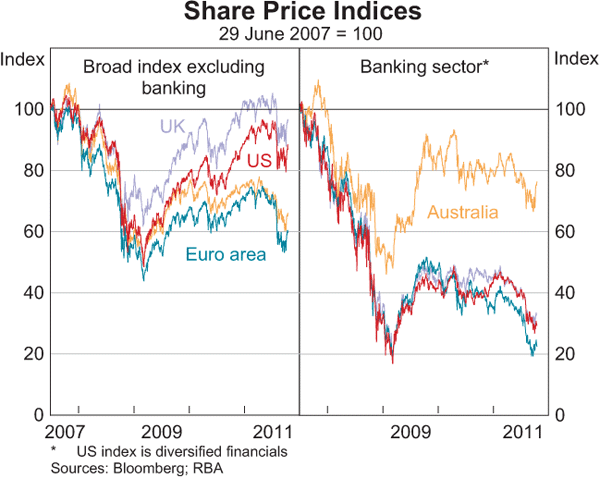
With the share prices as a backdrop, today I will focus on one particular aspect of the banking sector that is causing concern, primarily in Europe, namely the resilience of the funding structure. This issue has implications for all of you as corporate treasurers as it flows on to you in terms of price and volume, although not necessarily always in a negative way: we have seen some corporates able to access markets directly on better terms and conditions than financials.
As the concerns about the fiscal sustainability of the euro area have intensified in recent months, and have spread to the financial system, there has been increased pressure on bank funding.[2] The cost of funding for European banks generally has risen, while many banks in the European ‘periphery’ countries have all but been locked out of funding markets. As an illustration of this, the cost for banks to borrow euros from each other has risen sharply since significant concerns re-emerged about Greece in May this year. Graph 2 shows that the cost of European banks borrowing from each other in the short-term unsecured market has risen to its highest level in the post-Lehman period, reflecting heightened counterparty concerns.
By way of contrast, the equivalent spread in the Australian market (the spread between the bank bill rate and the expected cash rate), while higher than earlier in the year, has remained markedly lower than that in Europe. There have been spikes in this spread on occasion in the past few months, but they have reflected sharp downward movements in the expected cash rate, rather than upward movements in the bank bill rate.[3]
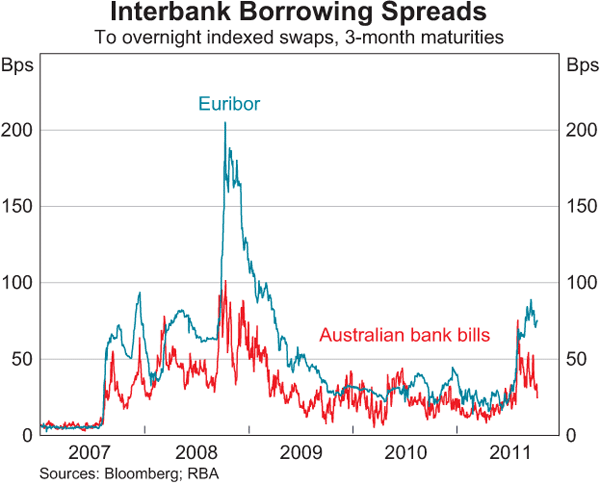
To mitigate the impact of the sharp increase in the cost of unsecured interbank lending for European banks, the ECB has recently announced an expansion of its open market operations. Since May 2010, the ECB has stood willing to provide three month funding to banks in unlimited amount (against acceptable collateral) at its policy rate. At its most recent meeting in early October, it lengthened the maturities for which it was willing to provide this funding to terms as long as 13 months. That is, banks can source unlimited euros from the ECB at fixed interest rates for periods of at least one year. Thus European banks should not have difficulty in sourcing euro funding for some time to come, provided they hold the appropriate collateral. The ECB is intermediating the interbank market, thereby circumventing the counterparty concerns, as has long been the proper practice of central banks in periods of stress at least since Bagehot.
The take-up of this short-term liquidity by banks in Europe is reflected in the expansion in the balance sheet of the ECB.[4] Since April this year, the ECB's lending to banks has grown by about €180 billion (or 40 per cent) as a result of these operations, with the bulk of the increase occurring since July. Graph 3 shows a breakdown of the lending for selected countries. It shows that banks in the euro area periphery, particularly those in Greece and Ireland, have been relying heavily on ECB loans for the past year or two (Graph 3).[5] This is even more stark if shown as a share of total banking sector assets (Graph 4). These data are mostly up until the end of September (except France and Greece which are August). They show the pick-up in borrowing from the ECB by Italian and Spanish banks since the middle of the year and a rise in borrowing by French banks in August.
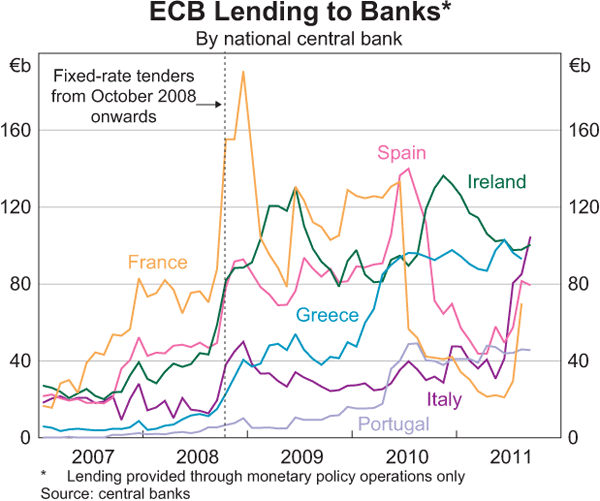
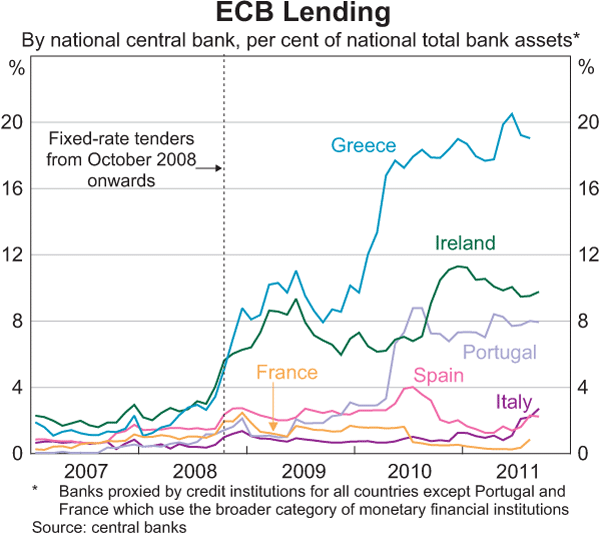
By way of contrast, the RBA's provision of liquidity has not changed in recent times. Australian banks' deposits with the RBA (ES balances)[6] have remained around $1¼ billion for over 18 months now.[7] More generally, we see little sign of strain or counterparty concern in the local interbank market.
Bond issuance by banks globally has fallen sharply in recent months. A partial, but not complete, explanation for the low level of issuance is that bank balance sheet growth globally has been very low and even negative in some cases. Graph 5 shows that unsecured bond issuance by euro area banks has been at very low levels, but until recently, secured issuance in the form of covered bonds had been relatively robust. This is indicative of a general trend for investors to take greater comfort in secured rather than unsecured exposures.
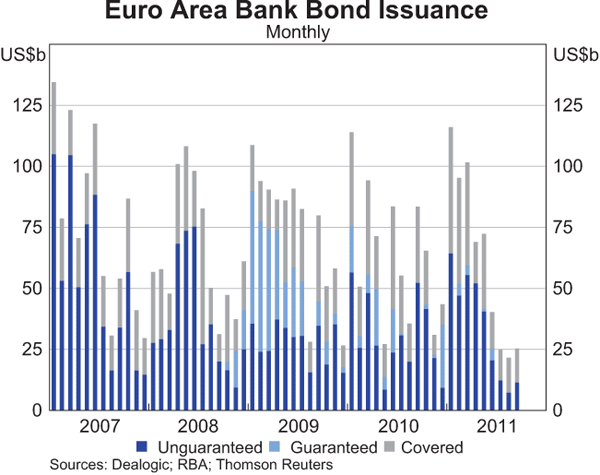
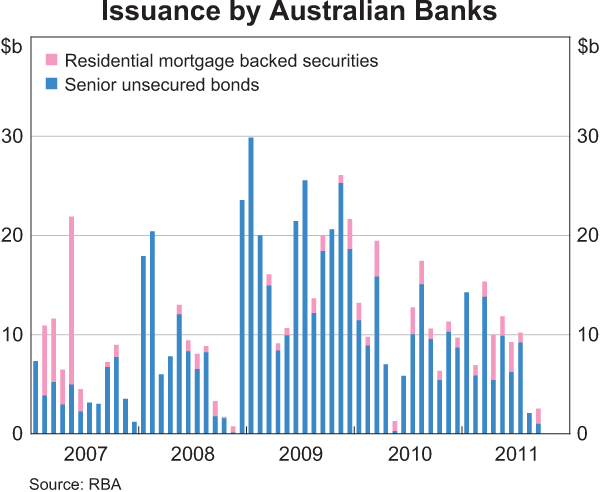
Graph 6 shows the issuance by Australian banks. The secured issuance by the Australian banks has been in the form of mortgage-backed securities (RMBS). However, the Australian Parliament last week passed legislation permitting the issuance of covered bonds by Australian banks. As a result, one might expect to see some covered bond issuance by local banks in the near future, given the apparent preference of global investors for this product in the current environment. As market volatility has increased in recent months, issuance by the Australian banks has also declined. As the Reserve Bank has noted on a number of occasions,[8] the Australian banks are much better placed to ride out these periods of volatility than in the past. This is for a number of reasons, including that deposit growth has outstripped credit growth for more than two years now, thereby reducing the banks' need to access wholesale debt markets, and that banks have increased their use of longer-term funding.
Let me make a brief detour into the world of credit default swaps (CDS). A number of commentators have pointed to the large rise in CDS premia for Australian banks in recent months. Graph 7 shows this rise, and also shows that, to a large extent, it is reflective of a rise in bank CDS globally. The rise in CDS appears to be much larger than the rise in primary unsecured issuance costs, although it is difficult to gauge exactly where the latter are, given the low level of issuance recently. But earlier in the month, the Commonwealth Bank issued an unsecured 3-year bond at a spread of 115 basis points over swap, 20 basis points wider than a similar issue earlier in the year, while the three-year CDS premium for the CBA has risen by 80 basis points over the same period.
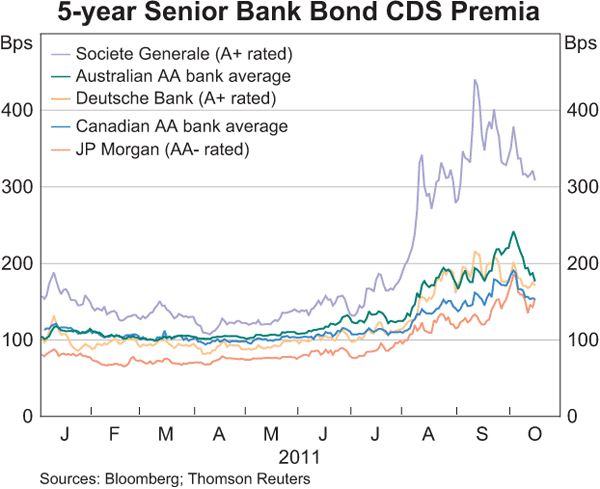
This divergence between CDS premia and issuance costs reflects the fact that, while subject to the same forces, they are not the same thing. While one is an insurance premium and the other contains a premium to compensate for a risk of default, there are other important elements too which differ. This is true for sovereigns, financials and corporates. To further illustrate this, it is interesting, particularly for you as corporate treasurers, to look at the CDS premium on BHP Billiton. As you may know, BHP has an extremely low gearing ratio. Its cash holdings have generally been about the same size as its outstanding debt. Notwithstanding this, at one point during the past month, BHP's CDS premium had increased by as much as 110 basis points since the beginning of the year. It appears that there are typically 2 or 3 trades in BHP CDS a day. From DTCC data, we know that there are certainly less than 50 trades a week in BHP CDS (this is also true of the Australian banks and the Australian sovereign CDS contracts), as that is the minimum number of trades that the DTCC reports. So the CDS premium does not have a lot of trading volume behind it, which potentially allows traders a cheap way (relative to a debt security) to take a position either on the entity in question or as a proxy for a broader position, such as the Chinese economy in the case of BHP and the Australian sovereign CDS contracts.
After that little detour, back to the bank funding story. So far I have talked about banks borrowing in their own currencies. But European banks have also experienced a substantial increase in the cost of borrowing US dollars to fund their US dollar assets.[9] While BIS data indicate that these US dollar asset positions of European banks have declined since 2008, they remain sizeable in some cases.[10] An important point to note is that these are US dollar assets which require US dollar funding. Many of these assets are of long maturity, but the associated funding of these positions tends to be at much shorter maturities. Therefore, these banks face ‘rollover risk’, both in terms of price and availability, on this US dollar funding.
European banks have a number of ways of obtaining US dollars including:
- short-term debt issuance, including to money market funds;
- deposits;
- secured borrowing;
- swapping euros for US dollars through the swap market;
- from the Fed or ECB, including via the US dollar swap line.
Exacerbating European banks' US dollar funding pressure has been a pull-back by US money market funds (MMFs) from holding debt issued by these banks.[11] These funds invest in highly rated short-term debt and that issued by European banks has traditionally accounted for a large share of their assets. Since concerns about a Greek default escalated in May, US MMFs have experienced significant investor outflows (Graph 8). The majority of this has been reflected in reduced holdings of European bank debt. Notably, these funds now hold no or negligible amounts of debt issued by banks in Greece, Ireland, Italy, Portugal and Spain. US MMFs have also shortened the average maturity of their asset holdings.
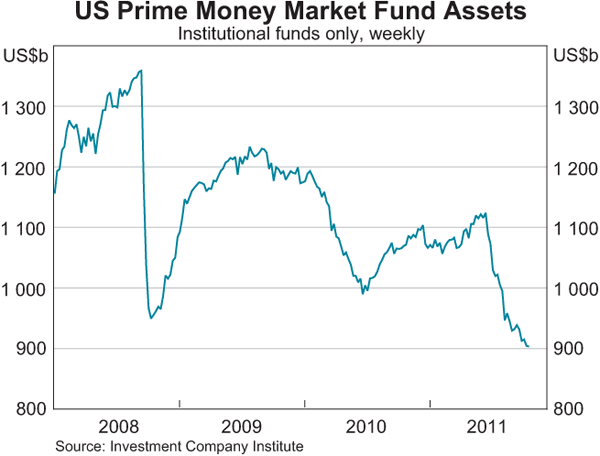
As this and other sources of funding have diminished, European banks have increasingly sought to obtain US dollars via foreign exchange swaps. As a result, the cost of doing this relative to the cost of unsecured interbank funding – the ‘basis’ – has increased substantially since May this year, although it remains below the peaks post-Lehman (Graph 9).
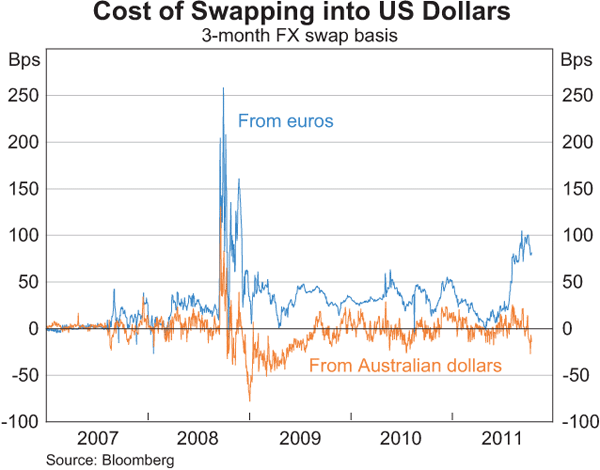
To counter the impact of this, in addition to sourcing more US dollars via foreign-exchange markets, some European banks are tapping US dollar repo markets for funding, reportedly, in some cases, with increased haircuts applied, and are also actively reducing their US dollar asset positions. European banks also appear to have built up cash buffers in US dollars earlier in the year. Cash holdings of foreign banks in the United States, presumably a reasonable share of which are European, had risen to over US$1 trillion from less than US$400 billion earlier this year before declining (Graph 10).
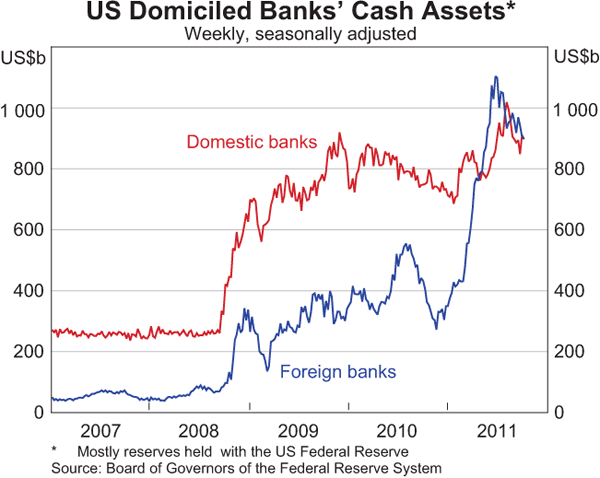
One important reminder from the financial crisis was that central banks can substantially help market functioning when liquidity strains emerge. As I mentioned earlier, European banks can access liquidity in their own currency (euros) effectively in unlimited amounts (as long as they have collateral). But to fund US dollar asset positions requires US dollars, not euros. Euros are useful if the swap market is functioning, but in the current circumstances, that market may not be open to all market participants. This certainly was the case in late 2008 and early 2009, when the provision of US dollar liquidity by the Federal Reserve to foreign banks through swap lines with other central banks clearly helped to alleviate European and other foreign banks' US dollar funding pressures (Graph 11). These swap lines effectively provided unlimited US dollar funding to these banks (again against appropriate collateral).
The swap lines ran off in early 2010 and while the major central banks maintained them at 7-day terms, they were barely utilised. In September 2011, three-month terms were re-introduced by the major central banks. But despite the recent tensions in US dollar funding markets, recourse to these central bank US dollar swap lines with the Fed has been negligible. At the ECB's three-month auction conducted in mid October, the take-up was only US$1.4 billion in aggregate by six banks. Nevertheless, the major central banks will conduct further US dollar liquidity operations with maturities of around three months in November and December.
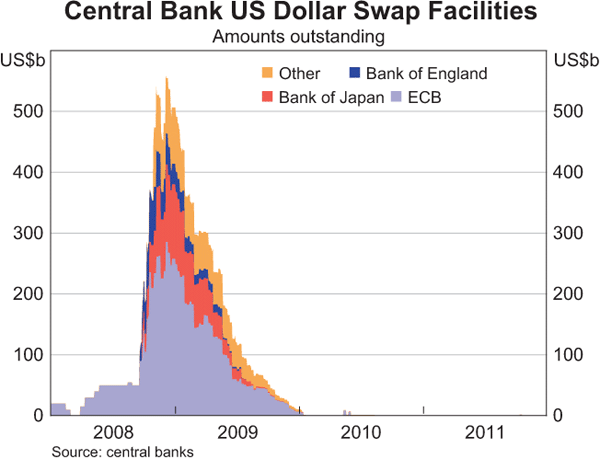
Turning now to look at the Australian banks' offshore funding, there are some important differences to the situation in Europe. Graph 9 also shows that the cost of swapping Australian dollars for US dollars has not increased in the most recent episode and indeed has gone negative at times.
There are some fundamental differences in the nature of the Australian banks' offshore funding. The funding that the Australian banks raise offshore, in US dollars predominantly, is swapped back into Australian dollars to fund Australian dollar assets. That is, the Australian banks are funding Australian dollar assets, not US dollar assets. Thus, if they experience increased difficulty in accessing US funding markets, this is resolved by sourcing Australian dollar liquidity, including in stressed circumstances from the Reserve Bank,[12] rather than trying to source liquidity in a foreign currency.
The swaps are generally of the same maturity as the funding, so there is no maturity mismatch. Moreover, given the use of CSAs and the net underlying position of the Australian banks, in the event of a depreciation of the Australian dollar, such as has occurred in the past two months, the Australian banks receive large inflows of US dollars into their collateral accounts, effectively increasing their supply of US dollar funding.
In contrast to the recent experience of some European banks, the Australian banks have found that US MMFs have been more than willing to maintain their exposures, including at longer maturities. Indeed, recently the Australian banks have been beneficiaries of a reallocation by the MMFs away from the European banks.
Conclusion
The banking system globally has been under scrutiny for much of the past four years to varying degrees. At the moment, we are in another period where that scrutiny is intense. My aim today has been to provide you with some context to that scrutiny, particularly around bank funding. The actions by the ECB, together with the Fed through the provision of the US dollar swap facility, should alleviate some of the funding tensions for European banks. In effect, provided they have appropriate collateral, European banks should be able to meet their liquidity needs in the period ahead both in euros, and in US dollars.
I have also provided some comparison with the situation facing the Australian banks. We are not seeing the same sort of stresses for the Australian banks, as are present for some of the European banks. The Australian banks' funding structures are considerably more resilient to periods of stressed markets than they were previously, given the changes that have occurred over recent years.
Endnotes
Thanks to Justin Fabo, Claudia Seibold and Dan Fabbro for their help. [*]
A number of these developments are discussed in detail in the Reserve Bank's September Financial Stability Review. [1]
See the discussion in the ECB's latest Financial Stability Review. [2]
On occasion, the sharp movements have also reflected factors including around the middle and end of the month as the reference bank bills move from one half of the month to the next. See Boge M and I Wilson (2011), ‘The Domestic Market for Short-term Debt Securities’, RBA Bulletin, September, pp 39–48. [3]
The ECB's balance sheet has also expanded as a result of its Securities Markets Program, whereby the ECB has purchased securities issued by Greece, Portugal and Ireland, and more recently Italy and Spain too. [4]
The decline in ECB lending to Irish and Greek banks in recent months has been partially offset by an increase in lending to those banks from their home central banks through Emergency Liquidity Assistance (ELA), which permits a broader range of collateral than the ECB. It also reflects the fact that their balance sheets are shrinking. [5]
One can assess the provision of liquidity from either side of the balance sheet. Here I am using lending for the ECB and deposits for the RBA. [6]
Except for the temporary increases in ES balances at month-, and particularly, quarter-end. [7]
See recent RBA Board Minutes and the RBA's September Financial Stability Review, as well as my speech delivered at the 23rd Australasian Finance and Banking Conference, ‘Bank Funding and Capital Flows’, Sydney, 15 December 2010. [8]
This has been a topic I have had a keen interest in for some time, including through chairing a working group for the BIS Committee on Global Financial Stability (CGFS) on the effect of central bank swap lines. See CGFS, ‘The Functioning and Resilience of Cross-border Funding Markets’, CGFS Publication No 37. [9]
See BIS Quarterly Review, September 2011. [10]
Useful analyses of the US money market funds are provided on a regular basis by JP Morgan and Fitch. [11]
See my speech delivered earlier in the year: ‘Collateral, Funding and Liquidity’, Address to Conference on Systemic Risk, Basel III, Financial Stability and Regulation, Sydney, 28 June. [12]
